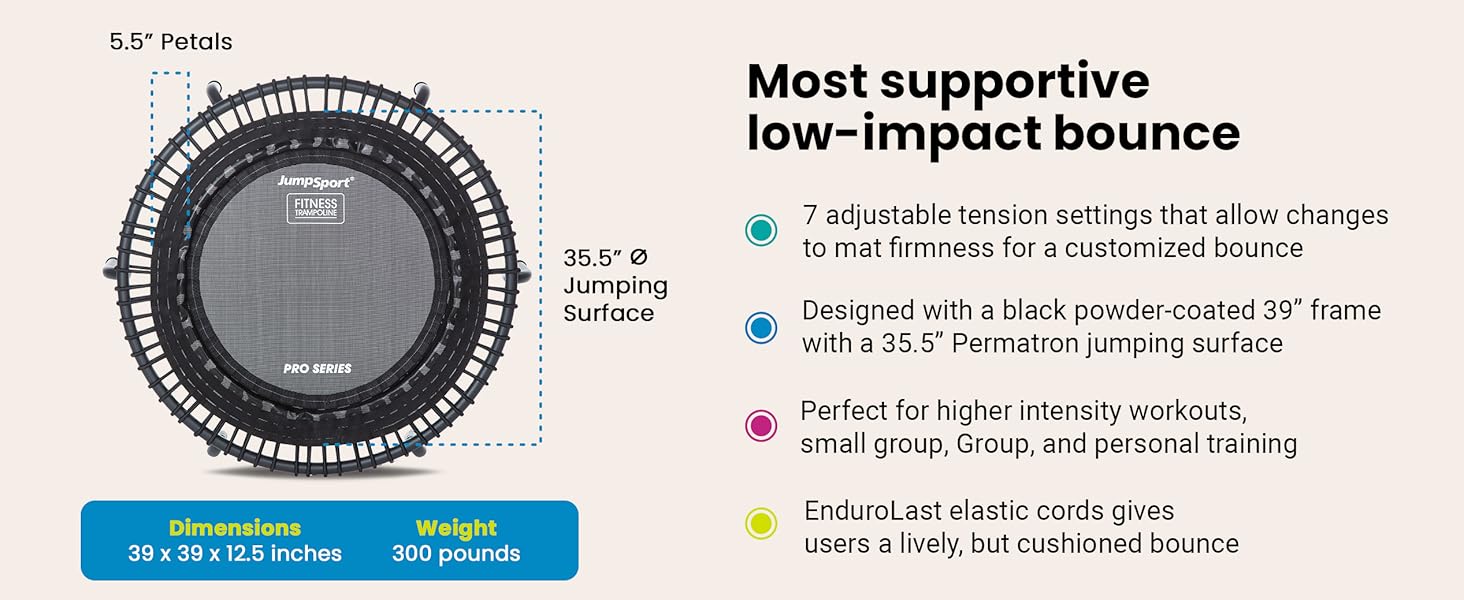Everything You Need to Know About Rebounder Trampolines
Rebounder trampolines, also known as mini trampolines, are a fantastic way to stay fit. They provide a low-impact workout good for cardiovascular health, strength, and coordination—all while being compact and easy to store at home. This guide covers everything you need to know about choosing the right rebounder, top recommendations, and answers to frequently asked questions.
 Click here for our favorite Rebounder pick
Click here for our favorite Rebounder pick
What is a Rebounder Trampoline?
A rebounder trampoline is a smaller, more portable version of a standard trampoline, designed for indoor workouts. Unlike larger backyard trampolines, rebounders are built with fitness in mind and are often used for cardio and strength training routines. They offer a controlled bounce, which is easier on joints and ideal for home workouts. To see my favorite pick, click here.
The Benefits of Using a Rebounder Trampoline
Click here for my favorite rebounder trampoline pick
Rebounders have become increasingly popular for their numerous health benefits, including:
- Improved Cardiovascular Health: Rebounding provides a heart-pumping workout that’s gentle on the joints, making it an excellent cardio option.
- Lymphatic Support: The up-and-down motion helps promote lymphatic drainage, which can support the body’s natural detox process.
- Core and Muscle Strengthening: Rebounding requires balance, engaging your core, legs, and glutes.
- Stress Relief: Rebounding can be a fun, mood-boosting workout that reduces stress and releases endorphins.
Types of Rebounder Trampolines
When choosing a rebounder, it’s helpful to know the different types available:
- Spring vs. Bungee Rebounders: Spring rebounders are often firmer, while bungee models offer a smoother, quieter bounce, which is gentler on the joints.
- Foldable vs. Non-Foldable Models: Foldable rebounders are easy to store and transport, while non-foldable ones tend to offer more stability.
- With or Without Handlebars: Some rebounders come with handlebars, which add extra stability. This feature is useful for beginners or those who need additional support during workouts.
Click here for our favorite Rebounder pick
Key Considerations When Buying a Rebounder Trampoline
To choose the best rebounder for your needs, consider the following:
- Size and Weight Capacity: Choose a size that fits your available space and ensure the weight capacity matches the user.
- Bounce Quality: Look for models with high-quality springs or bungees to ensure a comfortable and effective workout.
- Durability and Build Quality: Opt for sturdy frames and materials that will hold up over time, especially if you plan to use the trampoline frequently.
- Safety Features: Look for safety additions like non-slip mats, stable frames, and protective coverings over springs or bungees.
Top Rebounder Trampolines for Home Workouts
Here are some of the best rebounder trampolines available for home use:
| Brand/Model | Features | Size | Price Range |
|---|---|---|---|
| Leaps & Rebounds | Quiet bungee cords, large bounce area, sturdy | 40 inches | Affordable |
| JumpSport 250 | Silent FlexBounce, stable no-tip frame, workout DVD | 250 sq. in bounce | Mid-range |
| JumpSport 350 PRO | Adjustable bounce firmness, durable, arched legs | 35.5 inches | Higher-end |
| MaXimus Pro | Foldable, comes with resistance bands, workout DVD | Compact | Mid-range |
| JumpSport 370 | Customizable tension, stable arched legs | 39 inches | Higher-end |
These models offer different features to suit a range of fitness needs and budgets. Each of them is known for stability, high-quality bounce, and additional features that enhance the workout experience.
Top Exercises for Your Rebounder Trampoline
Rebounders provide a variety of workout options that are low-impact yet effective. Here are some popular exercises:
- Basic Bounce: A simple exercise to warm up and engage the whole body.
- Jumping Jacks: These are great for increasing heart rate while toning arms and legs.
- High Knees: Improve balance and strengthen the core by alternating knee lifts.
- Jogging in Place: This cardio option mimics running while reducing impact on joints.
Rebounder Trampoline Maintenance and Safety Tips
To keep your rebounder in top shape, follow these maintenance and safety tips:
- Check for Wear and Tear: Regularly inspect bungees, springs, and the frame for any signs of wear.
- Use on a Stable Surface: Place your rebounder on a flat, stable surface to avoid tipping.
- Clean as Needed: Wipe down the mat and frame regularly to keep your equipment in good condition.
Frequently Asked Questions (FAQ)
What is the difference between a rebounder and a mini trampoline?
Both are small trampolines, but rebounders are specifically designed for fitness, providing a softer, low-impact bounce ideal for cardio and toning exercises.
Can a rebounder help with weight loss?
Yes, rebounders are excellent for weight loss because they provide a full-body workout that boosts cardiovascular health, builds muscle, and burns calories effectively.
Are rebounders safe for all ages?
Generally, yes, rebounders are safe for most ages, but children should use them under adult supervision.
How much space do I need for a rebounder trampoline?
Most rebounders need about 3-4 feet in diameter of floor space, plus enough clearance overhead for safe jumping.
Do rebounders require assembly?
Some models arrive fully assembled, while others require setup. Many brands provide tools or instructions to make assembly simple, but it’s best to check with the manufacturer.
Click here for our favorite Rebounder pick
Final Thoughts
Rebounder trampolines offer an effective, versatile way to work out from the comfort of home. With so many options available, you can easily find a model that fits your workout style, space, and budget. Whether you’re looking to improve cardio health, strengthen your core, or just have a bit of fun, a rebounder trampoline is a fantastic addition to any fitness routine.

